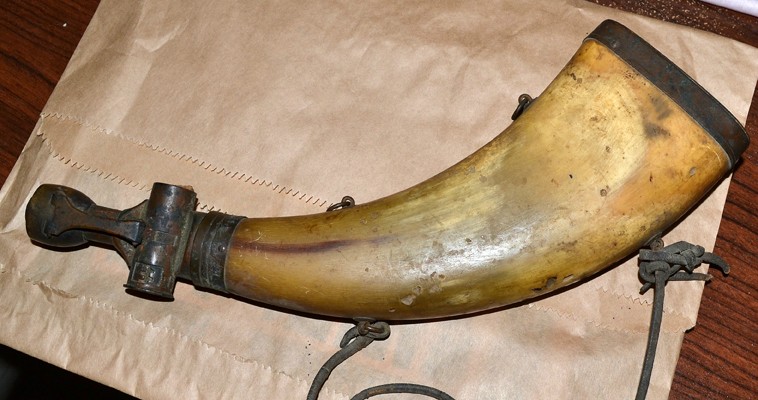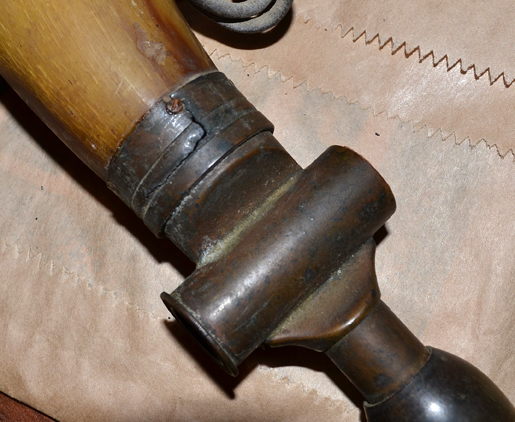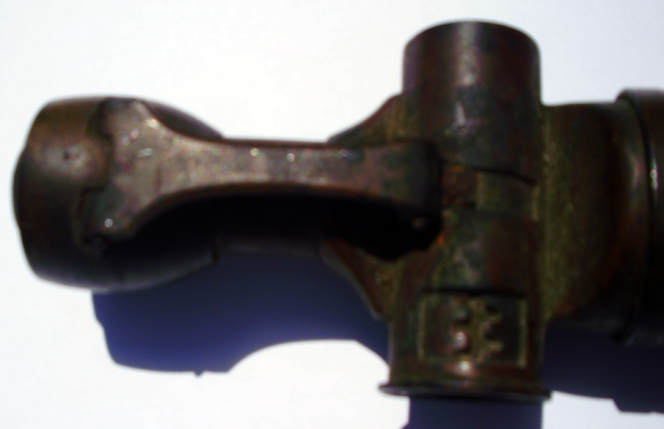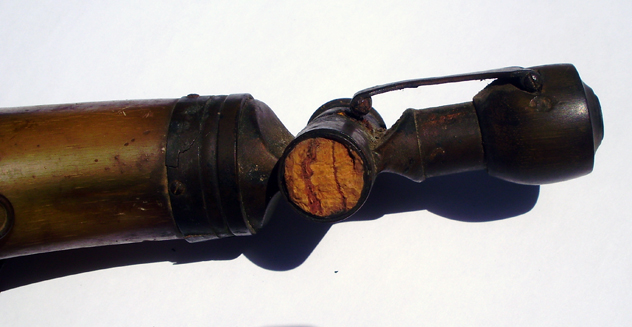Hello everyone. I recently picked up this powder horn at a yard sale. I thought it was pretty neat and the price was right, so I bought it even though it is well outside of my area of interest. I was curious if anyone had any tips for dating it or gathering other information about it. As a side note, it seems to still be full of what I assume to be black powder. It's also about 12 inches long from the tip to corner (not following the curve).
Here is a link to the images:
http://imgur.com/a/unJvW
I appreciate any help you can give me. :)
| Addison C. de Lisle wrote: |
| Hello everyone. I recently picked up this powder horn at a yard sale. I thought it was pretty neat and the price was right, so I bought it even though it is well outside of my area of interest. I was curious if anyone had any tips for dating it or gathering other information about it. As a side note, it seems to still be full of what I assume to be black powder. It's also about 12 inches long from the tip to corner (not following the curve).
Here is a link to the images: http://imgur.com/a/unJvW I appreciate any help you can give me. :) |
What a GREAT/UNIQUE Horn.
??-
1. Is it a "flat Horn ?
2. The spout appears to be metal . & looks to "function" as a "measure ?? If so, poss. Military ( ?)
3. Can you photo the "embossed " stamp on the spout. ??
IMO. a GREAT place to start is here -- http://thehornersbench.proboards.com/index.cgi? These people are Some of the top "horn" builders in the US + many are "historians"
Jack
It is a flattened horn of course. The valve is something I have never seen before although there are many different styles of valves in use. How does it function? It appears to be fairly old - I see some beetle damage. Interesting. Tell us more about it.
Pour a small amount of the contents into a pan and using a long match try to light it. If it goes off then you know for sure it is gun powder.
Pour a small amount of the contents into a pan and using a long match try to light it. If it goes off then you know for sure it is gun powder.
| Lin Robinson wrote: |
|
Pour a small amount of the contents into a pan and using a long match try to light it. If it goes off then you know for sure it is gun powder. |
Not sure of your experience with black powder. So just use a small amount of black powder as it will be exciting if it goes off, even more so than smokeless gun powder.
But I'll second what has been said on that being an interesting find.
[quote="Joel Minturn]
Not sure of your experience with black powder. So just use a small amount of black powder as it will be exciting if it goes off, even more so than smokeless gun powder.
But I'll second what has been said on that being an interesting find.[/quote]
I fired my first black powder firearm in 1968 and have been a regular shooter since. That is why I said a small amount and a long match.
Not sure of your experience with black powder. So just use a small amount of black powder as it will be exciting if it goes off, even more so than smokeless gun powder.
But I'll second what has been said on that being an interesting find.[/quote]
I fired my first black powder firearm in 1968 and have been a regular shooter since. That is why I said a small amount and a long match.
Lin- Don't worry I know you are familiar with black powder and that you defiantly know your stuff. I was just making sure Addison was aware that the Black powder reaction would be quite energetic. Maybe more than they were expecting.
So I agree use a small amount (even as small as a few grains) and a long match or match on a stick.
So I agree use a small amount (even as small as a few grains) and a long match or match on a stick.
Hello again. Thanks for the help so far. I don't really know much about it, as I just got it at a yard sale. I haven't actually been able to get the spout end to open due to rust (and I don't want to break it or devalue it by possibly messing up the patina with oil). I am pretty sure the whole tip picots on the tube, and there seems to be some sort of glass inside the tube, which is capped on the other end by a cork (broken off). The "embossing" on the tube doesn't look decorative to me, it looks like to crenelated walls facing each other and is fairly deep. It looks functional, but I'm not sure what it would do. Maybe it opened and closed at one point? That might be my guess, as the end of the tube above it has been textured like the edge of a coin, presumably for gripping. I'll take some pictures after work.
Forgive me for attaching these but it will make it easier to view and scrutinize. A couple of things strike me as a little different in terms of a powder horn until looking at the apparatus a bit more closely. My hunch is a priming hron with the lever actuating a measured charge. The glass view to confirm there is a charge to release. The cartridges were premade to contain powder and ball. Look to 17th century depictions of cartridges and horn hanging from the jackets/coats on European troops handling match locks and later equipment.
http://althistory.wikia.com/wiki/Lion_of_the_North
That link may be funky to post
1633: The College of Jena presents it's musket. It is aproximatly 11 pounds, and can fire (on average) 16 rounds every 10 minutes. Powder and shot would be contained together in a linen cartridge. When rammed down, small blades at the muzzle would slice the cartridge open, pouring the powder down. Everything else was the same as any other musket, exept for the fact that the snaphuance could be cocked back by pulling on the trigger guard, and the fact that the powder horn had a small lever to measure out exactly the right amount of primer. It was adopted as the Universal Service Rifle (mark 1). The musket was first assigned to the fusilers (troops tasked with protecting the Swede's amazing artillery).
A quick first link to a description but I have seen these in modern displays somewhere.
The whole assembly could be removed for further work by removing the pins/screws we see opposing each other. The measure part should unscrew one way or another from the throat for filling the horn but easy does it and it looks already damaged.
My assertion as a priming horn is the size of the chrge being dropped behind the lever's plate is too small to be a musket charge. Also, the knob end of it to facilitate an easy one hand grab and drop to the priming pan. At first I was thinking Kurdish and a full musket load but the glass view section and lever plate make it a small charge indeed.
Can we get a sense of overall dimension?
Cheers
GC
 Attachment: 86.72 KB
Attachment: 86.72 KB

 Attachment: 83.17 KB
Attachment: 83.17 KB

 Attachment: 189.44 KB
Attachment: 189.44 KB

http://althistory.wikia.com/wiki/Lion_of_the_North
That link may be funky to post
1633: The College of Jena presents it's musket. It is aproximatly 11 pounds, and can fire (on average) 16 rounds every 10 minutes. Powder and shot would be contained together in a linen cartridge. When rammed down, small blades at the muzzle would slice the cartridge open, pouring the powder down. Everything else was the same as any other musket, exept for the fact that the snaphuance could be cocked back by pulling on the trigger guard, and the fact that the powder horn had a small lever to measure out exactly the right amount of primer. It was adopted as the Universal Service Rifle (mark 1). The musket was first assigned to the fusilers (troops tasked with protecting the Swede's amazing artillery).
A quick first link to a description but I have seen these in modern displays somewhere.
The whole assembly could be removed for further work by removing the pins/screws we see opposing each other. The measure part should unscrew one way or another from the throat for filling the horn but easy does it and it looks already damaged.
My assertion as a priming horn is the size of the chrge being dropped behind the lever's plate is too small to be a musket charge. Also, the knob end of it to facilitate an easy one hand grab and drop to the priming pan. At first I was thinking Kurdish and a full musket load but the glass view section and lever plate make it a small charge indeed.
Can we get a sense of overall dimension?
Cheers
GC



Hello again,
Thanks very much for the information Glen (and for attaching my pictures); do you have an estimate on how old it might be? I have attached some more pictures, and taken some more measurements. Overall, following the outer curve the piece is 13 inches long. It is 3.25 across at the base, and around 1 3/8 inches thick. It does not taper distally. The viewing hole (in the tube) is 0.5 inches in diameter. Thanks again to everyone for helping me with this - I know nothing about historical (or modern, really) firearms and this has been very interesting for me.
 Attachment: 178.37 KB
Attachment: 178.37 KB

 Attachment: 141.92 KB
Attachment: 141.92 KB

 Attachment: 162.9 KB
Attachment: 162.9 KB

Thanks very much for the information Glen (and for attaching my pictures); do you have an estimate on how old it might be? I have attached some more pictures, and taken some more measurements. Overall, following the outer curve the piece is 13 inches long. It is 3.25 across at the base, and around 1 3/8 inches thick. It does not taper distally. The viewing hole (in the tube) is 0.5 inches in diameter. Thanks again to everyone for helping me with this - I know nothing about historical (or modern, really) firearms and this has been very interesting for me.



I'd not want to date it without seeing another just like it but despite it's size, still looks like a priming horn to me. The lever looks like it was bent over backwards and would have projected out at an angle towards the base of the horn.
The link offered by Jack is probably worth following up.
Four suspension points looks like it might have been a military pattern and would fall in line with a priming horn ffor someone with many cartridges. The link I posted relates musketeers back to the 17th century but we see priming horns well into the 19th century. A hunter would likely have had a smaller priming horn., as not expecting to enter a prolonged campaign.
Just some thoughts
Perhaps artillery/gunner as opposed to musketry, I just don't know.
GC
The link offered by Jack is probably worth following up.
Four suspension points looks like it might have been a military pattern and would fall in line with a priming horn ffor someone with many cartridges. The link I posted relates musketeers back to the 17th century but we see priming horns well into the 19th century. A hunter would likely have had a smaller priming horn., as not expecting to enter a prolonged campaign.
Just some thoughts
Perhaps artillery/gunner as opposed to musketry, I just don't know.
GC
Page 1 of 1
You cannot post new topics in this forumYou cannot reply to topics in this forum
You cannot edit your posts in this forum
You cannot delete your posts in this forum
You cannot vote in polls in this forum
You cannot attach files in this forum
You can download files in this forum
All contents © Copyright 2003-2006 myArmoury.com — All rights reserved
Discussion forums powered by phpBB © The phpBB Group
Switch to the Full-featured Version of the forum
Discussion forums powered by phpBB © The phpBB Group
Switch to the Full-featured Version of the forum